Senses Month: The Science of Sight
From ancient fossils to cutting edge surgery, we're bringing you the lowdown on the science of vision. Plus in the news, a drug that might aid stroke recovery, and what you can learn from taking a DNA test...
In this episode

00:46 - Black holes swarm around the Milky Way
Black holes swarm around the Milky Way
with Dr Charles Hailey, Columbia Astrophysics Laboratory, Columbia University,
This week scientists have provided the first evidence for a decades old theory that there is a swarm of black holes at the centre of our galaxy. We know a super-massive black hole sits in the middle of our milky way, but people have theorised that there are thousands more, closely packed in around it. But despite decades of searching, there was no evidence. Until now. By examining x-ray emissions from our galaxy, a team of scientists have identified what they think are 12 smaller black holes, which could be the first evidence for this gigantic swarm. Izzie Clarke heard more from Chuck Hailey, an astrophysicist at Columbia University in the City of New York.
Chuck - What we did is we found a dozen systems that have a black hole orbiting around a normal star. Such a system emits X-rays that we can actually detect with telescopes and these 12 systems are the tip of the very big iceberg that corresponds to these black holes that were predicted to be there by the theorists. And, in fact, when we work from the few that we see, this simple dozen up to the actual number we believe to be there, we get something very similar to what the theorists predicted of order 10,000 of these black holes.
Izzie - So it’s always been predicted that these smaller black holes would be there, and it’s only now that you’ve just found the first dozen?
Chuck - That’s correct. We found the first dozen by sorting through all the different sources that emit X-rays in the galactic centre, winnowing out the uninteresting objects and trying to zero in on these really fascinating objects, which are the black holes with a star orbiting around them.
Izzie - How can you even see these?
Chuck - Black holes are called ‘black’ for a very good reason; they’re hard to see. In fact, black holes don’t do much that would allow us to detect them. When they sit all by themselves they do eat gas and dust; that is their food but they’re not very good at converting their fuel into X-rays which we can actually see. But when a black hole captures a normal star which is moving by it, the star can send gas in a swirling mass around the black hole that we call an accretion disc, and these disks are very good at emitting X-rays. So we look for these black hole, normal star systems, and we see the X-rays that come from the gas that’s glowing at it swirls around and falls into the black hole.
Izzie - So you can’t actually see the black holes themselves, but you can see this ejection of X-ray emission and that indicates that they’re there?
Chuck - That’s exactly right. We can’t find these lonesome black holes, but if we’re lucky enough to find this dozen that have a companion star, then they’ll send out an X-ray signature that we can detect and identify them as black hole systems.
Izzie - How difficult is that to do?
Chuck - It’s actually quite difficult to do. These huge numbers of black holes are all crammed into the the galactic centre in a region about 6 light years across. And there’s an enormous number of not just black holes in this region, but many other types of cosmic sources that emit X-rays. In addition, there’s a huge amount of gas and dust in the galactic centre; that gas and dust is very hot and when things get that hot, more than 10 million degrees, they tend to emit X-rays. So these black hole binary systems, as we call them. which is just a black hole orbiting a normal star, are basically hiding in plain sight. They blended in the crowd, which is emitting these X-rays and we have to kind of tease them out from all these other sources which can emit X-rays as well.
Izzie - Gosh! So how exactly can you pinpoint the ones that you were hoping to find?
Chuck - It turns out that black holes with a companion star emit X-rays that, on average, are not as energetic as the X-rays that are emitted from most of the other objects that we would confuse with black hole systems, and an analogy I like to use is divisible light. We all know that blue light generally means something is hotter, and red light means that something is colder, and, in fact, the analogy is pretty exact when we look at these X-ray emitting sources. We were looking for the reddish looking objects which would be the black hole systems, and tying to winnow out the blueish looking objects or the hotter objects, which are the uninteresting X-ray sources.

05:36 - Is our data safe on social media?
Is our data safe on social media?
with Peter Cowley, Angel investor
Recently the headlines have been awash with stories about how our data are being used or abused by companies. Facebook is currently under fire for sharing up to 87 million users’ data with Cambridge Analytica, which has opened a conversation about personal data and what is and is not acceptable. Georgia Mills spoke to tech guru and angel investor Peter Cowley. First off Georgia asked Peter why our personal data is so valuable to social media companies...
Peter - Well, I’ll give you some figures: last year Facebook actually cost 20 billion dollars to run. Where’s that money coming from? In fact, they made a lot of profit out of that as well. That money is not coming from us as users, it’s coming from advertisers, so the advertisers are paying to put something onto Facebook which we can then consume. The numbers are huge because apparently Facebook’s got over 2 million users and a 100 billion ‘clicks’ per year. It’s only about 50 cents they get for each click but, at the same time, they’ve got to deliver the adverts that the advertiser wants to get to us. On Facebook, although I don’t seem to notice the adverts, 1 in every 5 posts is an advert, unlike on Twitter where it’s 1 in every 10.
Georgia - Right. So where as I might see an add on the train station or something like this, when you’re using our data you can really target it at people who you think might be more likely to buy your product?
Peter - That makes the click or the eyeball worth more.
Georgia - Facebook’s been at the centre of this debate but is it just them storing up lots and lots of personal data?
Peter - Not at all! The data might be different but, of course, Amazon is doing it; they’re suggesting you buy stuff. Google’s definitely doing it with the advertising, Microsoft’s doing it, Apple’s doing it and, on top of that although not in quite the same way, the banks, the Government, the NHS, insurance companies, everybody’s storing data on us.
Georgia - How well do they really know us then?
Peter - They know where we’ve logged in so that they can do some security. If somebody else logs into your Facebook account they’ll tell you etc., or Google, and they know your interests. You can check your preferences where I think we’ve both done. In my case it’s tech, finance, food, films, education but also, for some strange reason, I’m interested in basketball, which I’m clearly not! And, I think we’ll share this, I’m interested in the police; I’m not quite sure why.
Georgia - Yes, that came up on mine too. Facebook has this option where you can go in and see what it thinks you like and that’s how it uses the information to target ads at you. And yes, some of it was pretty straightforward; it knows I like horror films, video games and ukuleles - it know I like them. But it also said I like ‘reality’, which is an interesting one - a bit surreal. Plumbing, simply the word ‘pint’ and the rings of Saturn, which I really enjoyed. I think that might have something to do with my job as a science producer. Oh yeah, and’ play doh’ as well, so I don’t know how it got that idea.
Peter - It was nothing like as specific for me but because my tastes are somewhat different, I suspect. There’s a saying that we are the product of the tech giants, not customers of theirs. The customers are the advertisers and we’re the product, and they’re selling us which actually, if you look at it, is correct. But it’s not just the tech giants who are doing that because pay TV channels are, magazines, newspapers. They're selling the facts and what’s advertised so that’s what's advertised say in the Financial Times would be different from what’s advertised in the Sun, so it’s not just the tech giants doing it. It’s a way of targeting advertising.
Georgia - When this story broke there seemed to be quite a lot of surprise but as someone who works in the tech industry, what would your thoughts; were you surprised by this development?
Peter - I was surprised that Facebook had allowed the data to be harvested in that way. And, in fact, although it’s not quite an apology I don’t think, Zuckerberg did mention that and it has put some new rules in place to hopefully ensure, we’ll wait and see whether it works, that this sort of thing doesn’t happen again. I suspect that’s really difficult to police though.
Georgia - There’s questions of overturning democracy and things like that being being thrown around, but on a person level is it necessary a bad thing to have your data used like this?
Peter - It depends how it’s used. It depends on whether you trust the person that’s used and whether the people who are using the data are respecting your data. There will be good things and this as been covered on the programme before, our medical data sufficiently anonymised should end up with us having more specific treatment, or even specific drugs if necessary. Because medical treatment is a statistical chance of something happening based on your age, your sex, your location, etc., so that data will be very powerful.
But there’s a lot of things that could be connected with ‘big brother.’ The one that people talk about is if the insurance company detects you’re going to the doctor more, therefore your health insurance might go up. So yes and no; very specific to the data.
Georgia - What can an individual do about this?
Peter - Well, the extreme is to go completely off the grid so to only the old fashioned feature phones, not to have a smartphone, not to have an email address and everything but modern life doesn’t allow that. How do you buy a plane ticket if you’re completely off grid? The government's putting more and more services online like renewing your car tax.
The next thing is to come of social network of course, and I think a lot of people probably have done that. But there are advantages in doing that as well in terms of keeping in touch. What you should do, definitely, is regularly check your privacy setting on any of these, which you can do, they do allow that. Whether they give enough privacy setting, I don’t know.
There’s a new EU law coming in next month called the General Data Protection Regulations, which is pushing some of this responsibility onto the companies.
Georgia - Do you think the conversation that are being had now will lead to genuine change in the tech industry and in social media groups?
Peter - Absolutely! There are four stakeholders here: the users i.e. us, the advertisers, the platforms like Facebook etc., the regulatory governments, and there’s a lot going on. My crystal ball isn’t good enough to tell you what it’s going to be like in five years time, but there is change happening.

11:36 - The Naked Science of a DNA test
The Naked Science of a DNA test
with Dr Garrett Hellenthal, UCL, Julianna Cintron, 23andMe
Nowadays, a lot of companies offer online ancestry tests, or tests to quantify your risk of inheriting some life-changing diseases. But how seriously should we take their results? Izzie Clarke and Tom Crawford spoke to Garrett Hellenthal from UCL and Julianna Cintron from 23andMe in order to find out…
Tom - Fill the tube with saliva to the black wavy line… shall we just crack on?
Izzie - Okay! You get the idea. But in order for companies to analyse our genetic information, all we have to do is spit into a test tube and send it off to the lab. Tom sent his to a company called 23&Me to find out about his health and physical traits, and I wanted to explore my family history. So, how does a bit of my saliva reveal so much about my ancestry?
Garrett Hellenthal from University College London’s Genetics Institute…
Garrett - Well, it’s because that saliva contains your genetic code so it contains a series of cells, and each of those cells contains your complete genetic information. So what these companies do is they extract that genetic information from the cells in your saliva, and then they take that DNA and they identify a series of genetic markers that define your unique DNa sequence. They look at about 500,000 or so different pieces of genetic code, and then they’re going to take your genetic code and compare it that of the people that they have in their database and they identify who do you share lots of matching DNA patterns with. If you share lots of matching patterns with particular people from a particular area, that suggests that you may have ancestors that come from that area or, more accurately, it reflects the fact that you have descendants that now live in that area.
Izzie - That’s how it then corresponds to a place, for example?
Garrett - Exactly, yes. We don’t necessarily know that your ancestors came from that area themselves, but it could be true that they at least have descendants that live in that area. So you have to kind of make an assumption that if you’re matching to people in those areas, then the ancestors came from those areas as well.
Izzie - I’ve got my results and I’m slightly confused by some of them. I am 30% Irish and I guess that’s not too much of a surprise considering that a few of my great-grandparents were actually Irish.
Garrett - No, I don’t think so. With your four grandparents you’re expected to get about 25% of your DNA from each one of them, so your if you look back at your great-grandparents you get half of that, so you get about 12.5% from each one of them. If you have a couple of great-grandparents that came from Ireland you would expect to get about 25% of your DNA inherited from them.
Izzie - Okay, thats good. Then we’ve got 24% Western European and 15% Great Britain, so that's pretty accurate I would say, and then I’ve got 15% Scandinavian and I’m not entirely sure where this comes from. Does this mean someone in my family has been a bit naughty?
Garrett - It could mean that, but it doesn’t have to mean that. Because if we think of our ancestors back in time, we know that our great-grandparents, or great-great-grandparents; they have several children who might have other children and so on and so forth, but that this person has some descendants that live in the UK and some that live in Scandinavia, but it also could reflect that migrations from Norway into the UK. In particular during the 9th and 10th centuries there were a series of Norse/Viking migrations from Norway, for example. There’s also been anglo saxon migrations in the 5th and 6th centuries from areas around North Germany. All of these would be considered Vikings in some form and they did contribute and intermix with the local population.
Izzie - I’m just going to assume that I’m part Viking. But what about health and physical appearance? Let’s take a look at Tom’s results…
Tom - I think most of them are correct for me like I should likely have lighter eyes, and I have blue eyes. It says likely little upper back hair, and I can fortunately report I have minimal upper back hair. I was also pleased to see that I’m likely not to have a bald spot; I really hope that one’s true.
Izzie - In addition to appearance, Tom’s test was able to look at specific parts of his genetic code and explain the likelihood of there being a change called a ‘variant’, which could possibly lead to a life-changing illness.
Julianna - My name is Julianna Cintron and I’m a produce specialist on the customer care team at 23andMe.
There are definitely some traits that are more influenced by genetics than others. Having red hair is one of those traits where we found that there is a gene associated with having red hair, and so if you have two copies of that gene you’re more likely to have red hair. It doesn’t mean that you’ll definitely have red hair but it increases your chances.
Tom - Just with you mentioning there this idea of it’s to do with the confidence in something, or there’s a probability. We’re using phrases like more likely, it’s not sort of fixed. In my result I was told that I have a particular variant which leads me to be at a higher risk of Alzheimer's disease and I was just wondering what exactly does this mean? Does this mean I will get Alzheimer’s; does this just mean I’m above average likely; how does this result actually relate to the risk factor?
Julianna - We’re looking at variants that affect your likelihood of developing this disease. It does not mean that you’re going to get Alzheimer’s; we’re not a diagnostic service, so that’s the first thing to keep in mind, we’re looking at the e4 variant. The e4 variant is known to impact your risk of developing Alzheimer’s disease, so having one copy of the e4 variant just puts you at a slightly increased risk of having Alzheimer’s by a certain age. Having two copies of that would increase your risk a little bit more than just having that one copy.
Izzie - We’ve got to be a bit careful about how we look into these results, especially when it comes to health. Back to Garrett…
Garrett - Most of the genetic risks that we’ve seen thus far are relatively small, especially compared to environmental factors like smoking, or unhealthy eating, or just unhealthy lifestyles. So even if you carry a risk variants, you still may not be at much more increased risk relative to people who don’t carry that variance, and it probably very much pales in comparison to how your risk would increase if you’re say a smoker. You don’t want people getting these results and saying: ah, I don’t have the risk factors therefore I can do whatever I want. You also don’t want people getting these scores saying: oh no, I’m at risk of this so I’ve got to completely change my lifestyle. I think there has to be a lot of discussion about how people interpret these results and how best to relay that information.
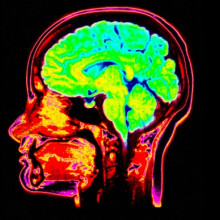
18:54 - A new drug could aid stroke rehabilitation
A new drug could aid stroke rehabilitation
with Professor Nick Ward, UCL
Strokes occur when a part of the brain stops receiving oxygen, due to either a clot or a damaged blood vessel, which causes that area to effectively die. They are one of the leading causes of death in the UK, but even if someone survives a stroke the effects can be severe, they can cause problems in speech, movement and memory, depending on where the ‘hole’ in the brain is. Recovery is a slow process, but now a paper is out in Science that has announced promising results of a drug designed to increase the speed of recovery and this has been tested in both mice and primates. Georgia Mills spoke to Professor Nick Ward, at the National Hospital for Neurology and Neurosurgery and UCL, who was not involved in the study, about why getting better from stroke is so difficult.
Nick - In terms of recovery, the ‘hole’ itself in the brain doesn’t fill in. People don’t recover by generating lots of new brain cells, they recover because the brain has the capacity for what we call ‘plasticity’ so, in other words, reorganising to improve function and that can lead to improvement in the ability of the person to do things that they weren't able to do before.
Georgia - Right, so it’s kind of flexibility?
Nick - Yeah. What we call plasticity, so a change in the structure of the brain that leads to an improvement in function over a period of time.
Georgia - Tell me about this new paper then; what have they done?
Nick - We just mentioned the fact that plasticity is an important idea when we come to think about recovery from stroke. Most of recovery is going to take place because of some kind of behavioural intervention so, in other words, if you have a problem with moving you need to practice the moving, usually with the help of a physiotherapist or an occupational therapist. If you have a problem with communicating you’ll work with a speech language therapist. You usually require hundreds or thousands of hours in order to try and recover.
Now, in heath services around the world, we’re struggling to deliver that kind of dose of therapy and so the idea behind the science of recovery is that it might be possible to somehow improve the potential for plasticity in the brain so that the same amount of therapy is going to have a bigger effect. In this paper they’ve looked at a drug which is changing the potential for plasticity and it does that by increasing ampa receptors. Ampa receptors are important for regulating what we call ‘inhibition’ or ‘excitation’ in the brain. If there was a little bit less inhibition and a bit more excitation, the brain will be more plastic, so for the same amount of training you should have a bigger effect. They use this drug in animal models of stroke to see what the effect was on a rehabilitation training regime.
Georgia - What did they find?
Nick - They were able to speed up the rate of recovery in animals who were treated with the drug. What they did, which is relatively unusual, was that they moved the experiment into primates. Three monkeys didn’t receive the drug and three did, and they found that the improvements in performance on an arm reaching task improved in the treated group. Most of the work that gets done in this field is done in the rodent model, and what they argued was if we’re going to translate it into something that works in humans, then we need a model that’s a bit closer to humans.
In terms of the general approach, in other words using drugs or some kind of intervention that increases the potential for plasticity, I think that it’s important to say that this idea has been around for a long time, you really need to couple training with the drug. The drug by itself, which might change brain state, is not the thing that leads to recovery, it’s training itself, so it might maximise the effects of training.
Georgia - As someone who’s a specialist in this field and a looking at this paper, how hopeful or you or how much significance would you attribute to it?
Nick - I’ve always been hopeful that we’ll be able to take one of the many drugs that have been studied in this field and understand how to use them. But one would temper that enthusiasm with the fact that we haven’t really been able to deliver enough, or a high enough dose of rehabilitation to patients and this applies not just to the UK, but this goes throughout the world generally. The training that you require in order to get better, the rehabilitation training, is really insufficient - we're delivery tiny tiny doses. The worry that we have is that even if you come along with a drug like this, if you maximise the effects of not very much, you still have not very much. So what we really have to fix first is systems that are going to deliver big enough doses of therapy that are going to make a difference to patients.
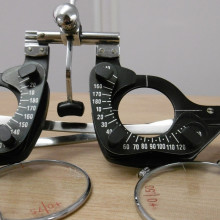
24:15 - The A-Z of an eye test
The A-Z of an eye test
with Dr Keziah Latham, Anglia Ruskin University
Regular eye tests are a good idea for keeping tabs on your vision, but how do glasses actually aid your sight, and what are optometrists looking for when they shine those torches in your eyes? Katie Haylor took a trip to Anglia Ruskin University’s eye clinic to meet optometrist and reader in hearing and vision science, Kez Latham.
Kez - An eye test is very much a routine part of your health maintenance. A regular eye check, in the same way as a regular dental checkup, is a really important thing to make sure that your eyes are working as well as they can be, and to spot any signs of things going wrong at an early stage.
There’s two main parts to an eye examination: the first part is to check the refraction of the eyes; we want to make sure that you can see as clearly as is possible and find out what lenses, if any, we’d need to put in front of the eyes to help you see as well as possible. The second part is to look at the health of the eyes.
Katie - Well, I think I’ve put it off for long enough now; I’m going to have to get in the chair so shall we crack on… It’s quite comfy actually.
Kez - What we want to do to start with is to see how well you’re seeing with your current specs as you're a spec wearer.
Katie - F, H, V, N, H. D, E, F…
By reading the lines of letters which got smaller and smaller further down the chart, Kez was establishing my baseline eyesight. And from there she could do more detailed tests in order to establish how well I can see. But what are my eyes doing with the light that comes into them?
Kez - When light comes into your eye from an object that’s in the distance, the surfaces of the eye converge that light so that the light comes to a focus. First of all and primarily, the cornea, the front surface of the eye, has the most impact on bending the light.
And then, secondarily, the lens that’s within the eye has another effect on converging the light so that it comes to a focus. The lens has slightly less of an effect overall in terms of the power of the eye, but the crucial thing about the lens, in your eye at least, is that it can change its power and that’s very helpful when you look from looking in the distance to looking at close up, the lens in your eye changes power so that it can cope with the fact that the light is more divergent from a nearer object.
Behind the lens we have the posterior chamber of the eye filled with transparent material, because we want the light to get all the way through to the back of the eye until it reaches the final destination which is the retina. And that’s where all the magic happens because that’s where the light energy that’s reaching the back of the eye is going to get converted into nervous energy that then gets passed up to the brain so that we can see.
Katie - People often say they’re eight long-sighted or short-sighted, what do these terms actually mean?
Kez - Somebody who’s long-sighted has an eye which isn’t quite powerful enough, so the rays of light converge to a focus but not quite quickly enough so that focus actually forms behind the retina. So we need to move that focus a little bit further forward by adding a slightly more converging lens in front of the eye to bring that focus forward onto the retina.
Now, on the other hand, short-sightedness is where the eye is slightly too powerful for it’s length, so light coming into the eye is refracted or converged and the eye’s a bit too efficient at doing that. The rays of light are converged a little bit too much and they come to focus in front of the retina and then the light rays carry on, and by the time they reach the retina the image is blurred again.
Katie - So short-sighted people need diverging lenses in order to push the point of clearest focus backwards onto the retina. Whether you’ve got glasses, contacts, or even had laser eye surgery, the aim of the game is the same; it’s to adjust the way that light bends in the eye in order for it to fall spot on onto the retina.
There are other tests involved in an eye exam. Through assessing my vision with a series of lenses, Kez checked if I had astigmatic or rugby ball shaped eyes that can cause visual impairment. Other tests included checking if my eyes were working together well as a pair, and if the muscles around the eyes were doing their job well enough to allow me to move my eyes in all directions.
But it’s not just how well we can see that’s covered in an eye test. Optometrists also look into the eye itself.
Kez - There are certain specific structures that we want to pay particular attention to. The first thing that we look for when we look into the back of the eye is called the optic nerve head, where all the nerve fibres from across the retina gather and go up the plug hole to the brain up the optic nerve.
Katie - Can I put my glasses back on now? Oh gosh, they’re embarrassingly dirty.
By closely examining structures in the eye like the optic nerve head, optometrists can potentially pick up on changes indicative of certain conditions; for instance eye conditions like glaucoma, or systemic conditions like MS. But it’s not just the optic nerve head that’s important to check out, so once I got my glasses back on and the world became clear again, Kez told me about some other things that she looks for…
Kez - We also want to look at the macular in great detail; that's the area at the back of the eye where light is focusing, and so it’s the area of our eye with finest vision. When we look straight at something, it’s our macular or our fovea that we use for all sorts of fine resolution tasks like reading, recognising faces, reading car number plates, those kinds of things.
The other thing that we particularly want to look at, as well as the rest of the retina and any other changes that we’re looking for there, we also want to have a careful look at the blood vessels at the back of the eye. At the back of the eye is the only place in the body that you can see blood vessels directly without opening the skin, so it is very important to look at those blood vessels as being indicative of somebody’s general health. You can pick up signs of systemic diseases: things like high blood pressure, high cholesterol, and even diabetes by looking at the condition of the blood vessels at the back of the eye.
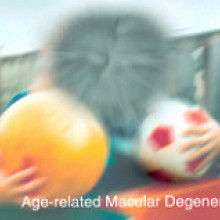
When vision goes wrong: age-related macular degeneration
with Professor Pete Coffey, UCL and Moorfields Eye Hospital
A part of the back of the eye called the retina is a crucial part of the visual system, it's here that light is converted to the electrical signals which are sent up to the brain. Issues with the retina can have severe consequences, and one such condition involves degeneration of the macula part of the retina, which can lead to the loss of central vision. Now scientists have implanted retinal tissue from stem cells into a small number of patients with age-related macular degeneration, and who’s sight has been restored. Pete Coffey from UCL’s Institute of Ophthalmology and Moorfields Eye Hospital spoke to Katie Haylor. First off Katie asked Pete to explain what the retina actually is...
Pete - We call it the neural retina, which is at the back of the eye which is a multilayered, thin piece of tissue, which, essentially, contains the light-sensitive cells plus the connecting cells which then take that information to the brain.
Katie - What are these light-sensitive cells?
Pete - The rods and cones. The rods deal with what’s called scotopic vision which is night vision, low level vision, and the cones deal with bright, colour vision. As Kez said, there’s an area in the retina which accounts for 10% of the whole of the back of the eye, which the macular region. It’s about 6mm in diameter and that contains the high contrast, the colour vision, the cone receptors which allow us to read, drive, recognise faces.
Katie - Once light hits the retina it gets converted into electrical signals which shoot on up the optic nerve. How does that conversion process happen?
Pete - There’s a number of events which occur. The light sensitive component, the cones, actually have packets of chemicals at the tips of those cells, which we call outer segments which contain the chemicals, the aldehydes which use chemical processes to convert light into electrical activity. That activation is then linked to the cell which then takes it into the brain via one more cell, which is called the bipolar and then its connection to the ganglion cell which takes that information and presents it to the rest of the brain.
Katie - We mentioned age-related macular degeneration; it’s one example of what can go wrong with the retina, so what exactly is it and who gets it.
Pete - People over the age of 65, and it’s the layer of cells which give nutrients to the seeing part of the eye, the neural retina, that die. There’s about 30% of people over the age of 65/70 will have some form of age-related macular degeneration. There are two forms: dry and wet. The distinction is the wet form is due to blood that appears at the back of the eye as well, which is rapid. That is the only treatable form of the disease, but that only counts for 10% of the clinical population - 90% is untreatable. There’s checks on whether you smoke; smoking can increase the rate of the disease. There’s some nutrients which can be given but, basically, the only form which is treatable is the wet form.
Katie - Tell us about your work on treating AMD, because this involves stem cells, doesn’t it?
Pete - It does. In age-related macular degeneration those cells which support the seeing part, the neural retina, die. There’s a number of reasons why that occurs but, effectively, because those cells die the seeing part of the eye no longer has the nutrients, etc. and therefore, over time, it itself dies. What we’ve engineered is making those eye cells, those support cells which are called retinal pigment epithelium, and we put them back in exactly the same format as they are at the back of the eye. So they’re in a single layer, on a carpet of cells, which we’ve surgically then implanted into the back of the eyes of those patients, and they’ve been there now for nearly 2½ years.
Katie - That does not sound like an easy process, so what was involved in creating these cells from these stem cells?
Pete - Actually, it is an easy process. I get very embarrassed about that particular position, because most people who are trying to make a specific cell from a stem cell have gone through a very difficult process, so people who are trying to make cells for Parkinson’s disease, or heart cells, or liver cells. Literally, all we have to do is take one component out of the fluid in which we keep cells and that’s just one component. It’s called basic fibroblast growth factor and then the cells spontaneously make the eye cells that we want.
Katie - Oh brilliant!
Pete - So actually it’s quite easy. Anyone could do it so to speak. Although it did take us a bit of time to realise that!
Katie - How many people did you put these cells into?
Pete - We’ve only put them in two patients but there’s been a lot of preclinical work to make sure that if we put those cells back, we are going to see a difference. They’re reading again, which wasn’t possible. They couldn’t even see the book before we did the operation.
Katie - Lastly, what could this mean for AMD sufferers in the future? Do you think this could be cost-effective enough to use in thousands of people in the future?
Pete - Yeah. There’s 700,000 patients who suffer from AMD. Not all of those would be treatable with this particular therapeutic, but a good 10% of them could be. I mean, that’s till a big number, you know, that’s 70,000 patients. We believe that we can produce enough of these patches to treat that type of a clinical population and the cost would be a huge saving to the NHS, and not maintaining people but actually giving them some sight back. This is probably one of the first studies which has actually shown that regeneration, in terms of stem cell regenerative medicine, is feasible and does have some efficacy.
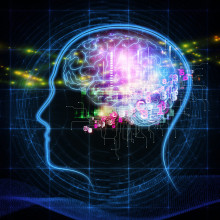
38:23 - How the brain processes images
How the brain processes images
with Dr Hugh Matthews, Cambridge University
Once light information which has entered via the eye has been converted to electrical signals, how does the brain use this information perceive the world around us? Georgia Mills spoke to Hugh Matthews from the University of Cambridge, asking first of all how the brain goes about processing the vast quantities of visual information out there.
Hugh - The first step to dealing with the information overload is we’re not actually sampling the visual image with equal clarity in all of its parts. There’s a central region of the retina where the photoreceptors are packed very tightly together. These very tightly packed cones in the central region called the fovea give you a very detailed picture of just that little region, but the further out towards the periphery of the retina you move, the less densely sampled is the visual world and we’re scanning this little resolution patch back and forth over objects of interest all the time, so that’s the first solution.
The second is, even within the retina itself, the visual system is retaining only those aspects of the visual image that are important to it, especially information about boundaries, about changes in the image. It’s throwing information away information about regions of the image that don’t change so it only keeps what it needs for further analysis.
Georgia - So when I’m looking at a scene, I might not actually be processing all of that information; my brain is filling in some of the gaps?
Hugh - A lot of filling in of gaps. It gives you the illusion that your perceiving everything with equal detail all the time.
By the time the signal is sent through to the optic nerve, to the brain, it first needs to be converted into a sort of digital form. All this processing within the retina has happened as analogue continuous signals, but to travel along the optic nerve towards the brain and, therefore, travel a long distance we’ve got to convert it from a graded continuous signal to a digital like signal of individual nerve impulses or spikes.
These are then sent onwards via a sort of way-station on the way to the brain where they’re refined a little further, to the first part of the cortex, the brain itself that processes the visual information in detail, the so-called primary visual cortex. There’s been a little sorting out on the way there of the individual nerve fibres because each eye receives information from the whole of the visual scene. And what we want to do is sort the information from one side of the visual world from each each eye’s view so that all of that information from both eyes goes to the other side of the brain. The right hand side of the brain is receiving information about the left hand side of the visual world and visa versa.
Georgia - So they’re swapping over?
Hugh - A sort of partial unscrambling of the signal, so that all of the information representing one half of visual space ends up on the other side of the brain so that we can ultimately compare what each eye sees so as the judge the relative distances of objects away from us by comparing two eye’s views.
Georgia - Oh I see, so we don’t have to look at two images all the time as well, we can see just one image in front of us?
Hugh - Exactly.They get unified together into one at the level of the primary visual cortex. Also any differences between the two eyes used can get analysed so that we can decide whether an object is closer to us or further away from us than the point at which we’re actually looking at that moment.
Georgia - How does all the information that’s coming at us like the colour and the movement, how does that get coded by the brain into something we can understand?
Hugh - Well, an important principle for processing in the brain is parallel processing of different streams of information. Within the primary visual cortex, the spatial structure of the image, the presence of edges, and little segments of lines forming the boundaries between objects and their backgrounds, those are analysed as part of one stream. The colours are analysed by separate cells as part of another stream, and motion is analysed as a third processing stream. Ultimately we’re going to have to bring all of those together so that we can actually perceive what the system has seen.
Georgia - Oh right, so different parts of the brain divvy up the work as it were?
Hugh - Very much so. If you move to higher levels, you can find visual areas that are specialists in colour processing, specialists in motion processing, and specialists in the spatial structure of the image separating out objects from their backgrounds. You can even get some quite elaborate stimulus preferences: there is a little region of the brain that is believed to be principally looking for faces, familiar faces in particular. If you were to damage any of these specific areas, you’d lose the ability to carry out that particular type of visual perception; for example you can lose at a cortical level the ability to perceive colours. You can use the ability through damage to another region to perceive motion. And, most strangely of all, you can lose the ability to perceive faces, both familiar and unfamiliar. You may not even be aware that they are faces.
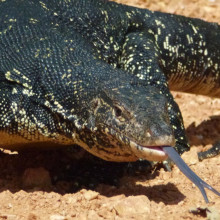
44:17 - Fossils of ancient lizards reveal a fourth eye
Fossils of ancient lizards reveal a fourth eye
with Dr Krister Smith, Senckenberg Research Institute, Germany
Most of us, hopefully, have two eyes. But way back in our evolutionary past we may have had even more. Now some reptiles still have this third eye, it’s called the pineal organ, and is a dot on the top of the head that responds to light. Now, scientists have found an extinct lizard with a fourth eye, something that hasn’t been seen in a land dwelling animal before. So what is this eye, and what does it change about our understanding of eye evolution? Georgia Mills spoke to paleontologist Krister Smith from Senckenberg Research Institute in Germany...
Krister - This lizard belongs to a lineage which entered North America about 56 million years ago, and went extinct there around 34 million years ago. It was a monitor lizard; it would have been active, intelligent, and carnivorous, and well over one metre long. And what greatly surprised us is that it appears to have four eyes rather than the usual three.
Georgia - When you say eyes, I picture a normal human eye. I’m guessing they’re not like that so what were they like, and what did they do?
Krister - They would have appeared to us rather different than out lateral eyes, but in another sense they are, anatomically speaking, well-developed eyes. Your lateral eyes are, in fact, part of your brain and the same here applies to the pineal organs. They are outgrowth of the same part of the brain and, in lizards at least, they acquire a ball-like shape with a lens-like layer, and a cornea, and a retina-like like layer and, in that sense, they are eyes. They also perceive light and they’re indicated on the top of the head by a pale spot, which allows the skin to transmit light to the eye.
Georgia - What about this fourth eye, does that exist in anything around today?
Krister - There is, in fact, only one small group of vertebrates today which have four eyes, and those are the lampreys. They’re jawless fish, so they’re fairly distantly related to us or to any of the bony fish that we’re familiar with, or even to sharks. But, like the lizards, their additional eyes are indicated on the top of the head by a pale spot.
Georgia - Do we know what it’s for?
Krister - It’s a remarkable thing that after some 150 years of study, there’s still a great deal to be learned about the functions of the pineal organs in organisms outside of mammals. They have a number of functions just like in mammals. They tend to help regulate the daily cycles, but in lower vertebrates where the pineal organs form additional eyes, they have other functions as well. There is evidence that they are able to use short wavelength light, in particular the polarisation of short wavelength blue light coming from the sky to orient themselves geographically.
Georgia - This sounds really really useful. Why don’t I still have this pineal eye on top of my head?
Krister - One thing that we know is that an additional eye on the top of the head regressed inside the skull like it is in mammals today. In a great number of lineages independently, just thinking about the land vertebrates, it’s gone as a third eye in many amphibians, in mammals, in turtles, crocodiles, bird; it’s gone, and we don’t really know why.
Georgia - Right. We knew about this third eye before, but you’ve found that the fourth eye was in reptiles, which we didn’t expect. What was the evidence for it; how do you know this was indeed the fourth eye you’re looking at?
Krister - We compared the typical third eye with this new hole that we found, that is ultimately what lead us to our study in this particular part of the brain. We had not just a single hole on the top of the head but rather two holes, which is very unusual, and the first thing that we did, of course, was to examine other specimens to make sure that it’s not simply some strange malformation in a single specimen and, in fact, it does occur in others as well. It seems to have appeared somewhere between 52 and 49 million years ago, and there’s a limited number of structures in that part of the head that could possibly account for this extra hole. So we examined them and came to the conclusion that the pineal organ was really the only explanation.
Georgia - What does your finding tell us about these organs evolved?
Krister - There’s much more dynamism in the evolution of these organs than we have previously given them credit for. We used to think that it was a very simple story: we have a pineal eye and it regresses into the brain in many lineages in parallel; however, we can now say that it’s much more complicated than that. The third eye in lizards is not the same as the third eye in other vertebrates and this leads us to to another point: if in lizards, the parapineal took the place of the pineal, then we have no idea when this happened. Every living member of land vertebrates, we know that our ancestors, the ancestors of mammals had a third eye, but we don’t know which organ it was.
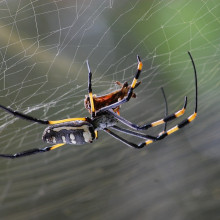
49:38 - Sensor of the Week: super-seeing spiders
Sensor of the Week: super-seeing spiders
with Dr Lauren Sumner-Rooney, Oxford University Museum of Natural History
Lauren Sumner-Rooney from Oxford University’s Museum of Natural History makes the case for the super-seers of the animal kingdom...
Lauren - I think lots of people would say that the champion has got to be the mantis shrimp. These guys have super-powerful arms for spearing and smashing their prey. So in complex and colourful habitats like reefs, they really need great vision to hit their targets.
Each eye is subdivided into parts so they can judge target distances using just one eye, where most animals need to use two. They’re also capable of detecting polarisation in light, as well as having 12 different types of colour sensitive cells, where we only have three in our eyes. Strangely, despite this difference their colour discrimination actually seems to be quite poor; much worse than ours because they seem to use each type in isolation rather than comparing signals between them.
So, for me, the other main contenders for visual super-sensor in the animal kingdom are spiders; they’ve evolved some incredible adaptations in their visual system. Most species have four pairs of eyes, each of which has three dedicated areas in the brain; they can be specialised to perform different roles and they often point in a different direction to each other.
Jumping spiders actually have two pairs of lenses inside their principle eyes, kind of like a telephoto camera giving them some of the highest resolution vision seen in any invertebrate, despite their tiny size. This ‘zoomed in’ effect restricts their field of view, but they’ve found a way around this by using specialised muscles to move the retina around the lens, and by arranging other pairs of of eyes around their heads to give exceptionally good peripheral vision. They’re also sensitive to red, green, blue, and UV light and appear to use these different colours to help them accurately judge distances, which isn’t known in any other animal.
Other groups have evolved completely different, but equally amazing abilities. Ogre faced spiders are deadly nocturnal hunters with some of the most sensitive eyes in the animal kingdom. Several other families, such as Wolf spiders, can also detect the polarisation pattern of the sunlight and use these to navigate using one or more dedicated pairs of eyes.
If any group deserves recognition for all round success, creativity, and diversity in vision, I think it’s got to be the spiders.
Related Content
- Previous Water on Mars
- Next Senses Month: Can you Hear Me?










Comments
Add a comment